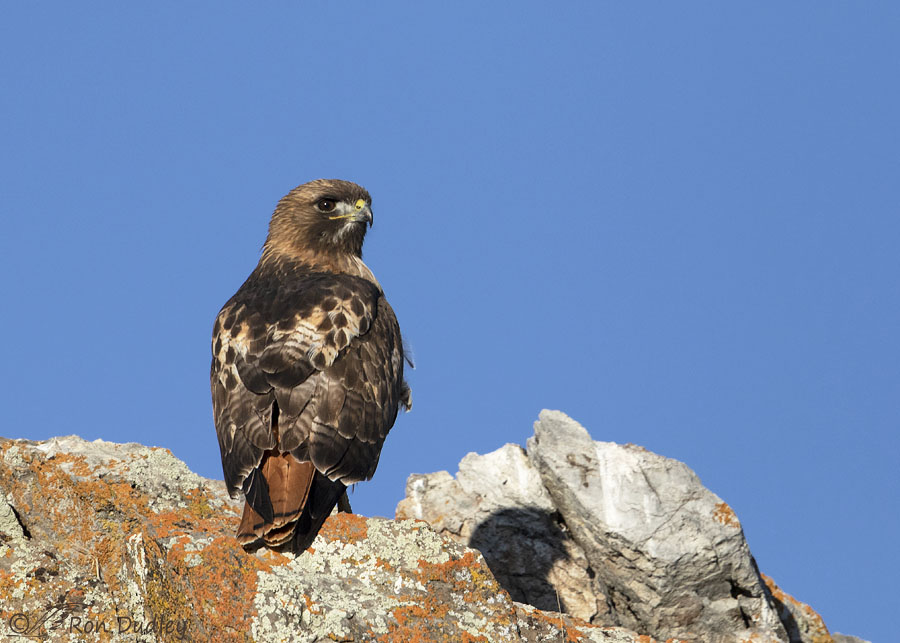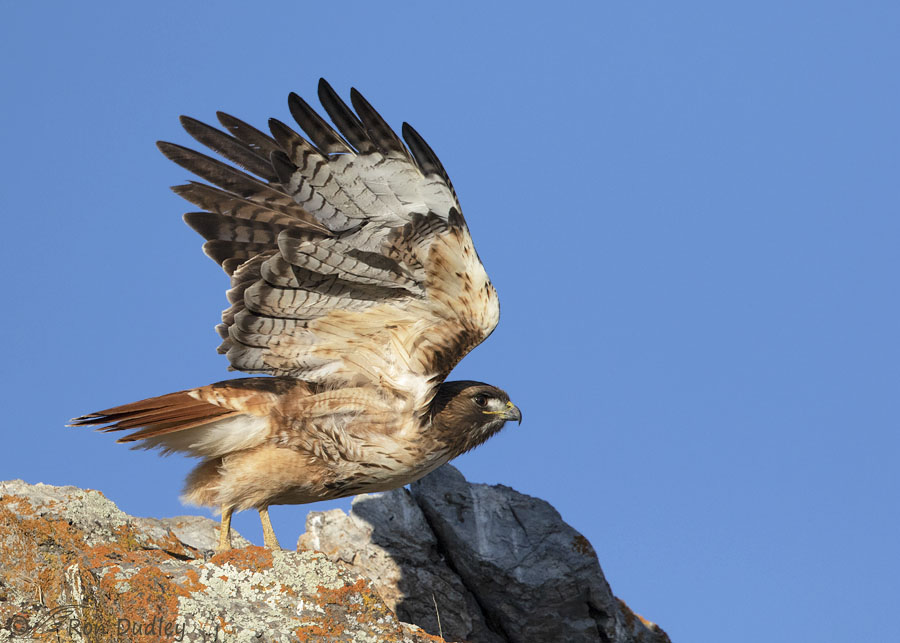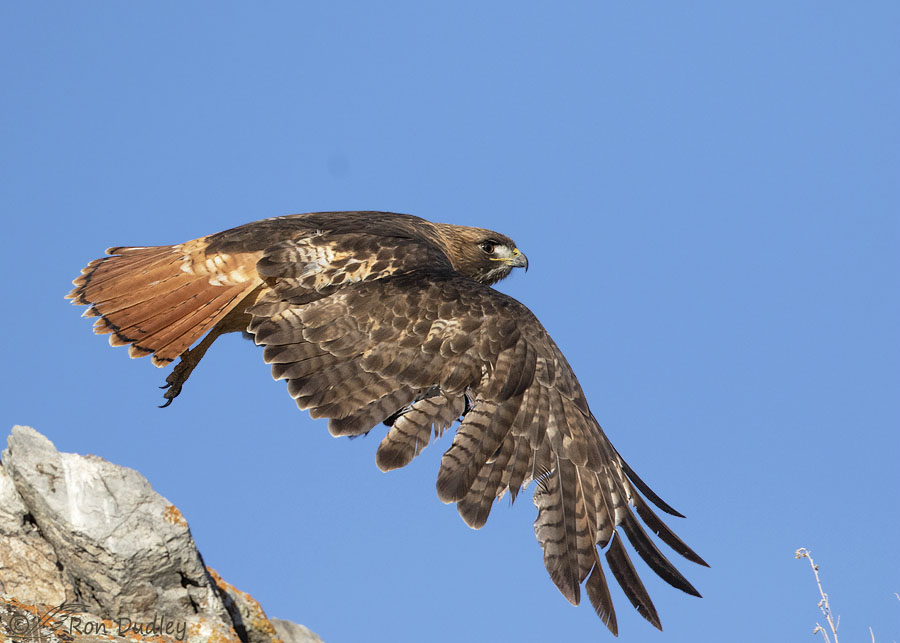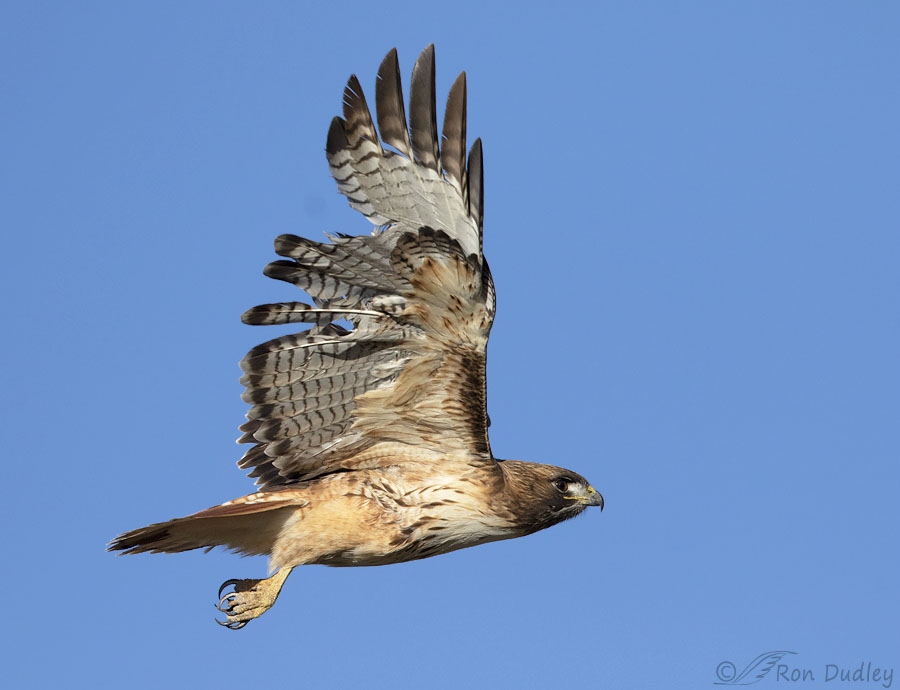Yet another hawk looking pretty beat-up from molt, this one from two days ago.

1/4000, f/6.3, ISO 500, Canon 7D Mark II, Canon EF 500mm f/4L IS II USM + EF 1.4 III Extender, not baited, set up or called in
This time of year you never know what our raptors are going to look like regarding molt until they open their wings. Two days ago this presumed female perched on a rocky point in northern Utah was looking pretty good, at first.
She had her back to me so chances were good that when she eventually left her perch she’d take off away from me.

1/4000, f/6.3, ISO 500, Canon 7D Mark II, Canon EF 500mm f/4L IS II USM + EF 1.4 III Extender, not baited, set up or called in
But she fooled me. Without much warning she turned on her perch and quickly launched to my right.
I’m still seeing little if any sign of molt.

1/4000, f/6.3, ISO 500, Canon 7D Mark II, Canon EF 500mm f/4L IS II USM + EF 1.4 III Extender, not baited, set up or called in
But when her right wing stretched out it looked like she’d been through the wars.

1/4000, f/6.3, ISO 500, Canon 7D Mark II, Canon EF 500mm f/4L IS II USM + EF 1.4 III Extender, not baited, set up or called in
Seven shots later in the burst when my shutter fired with her wing in the vertical position it looked even worse. That’s a lot of wing surface area to be messed up this badly and still provide enough lift for flight and effective maneuvering but she somehow seemed to manage it all pretty well.
Cornell’s Birds of the World has this to say about molt in Red-tailed Hawks:
- “breeding females typically begin replacing primaries during egg laying, and males a bit later, while mates are incubating. Nonbreeders and failed-breeders probably begin molting earlier”
Molt must be pretty darn inconvenient for birds but with all the beating they take feathers don’t last forever so it’s gotta be done.
Ron


Excellent shots and a wonderful dissertation by Laura. Man your post and her comment was very informative. Much appreciative!!
Wow, such great shots and Laura’s super poetry on feathers! What a treat.
Very nice photos. I always wonder if is some what painful to grow new feathers. Our parrots are always grumpy and angry during molt.
Thanks, April. I’d probably be grumpy too, painful or not.
Sensational series! Thanks for sharing!
Charlotte Norton
Wow– between you, Sally, and Laura– the sum of your responses add up
to a seminar on feathers ! Thanks to you all.
Thanks, Kris. My readers are often very instructive with their comments.
THANK YOU. And all those who comment on your ship and start my day with learning, with awe, and with wonder.
There is a touch of jealousy too this morning. I could do with a really thorough moult (and rejuvenation).
I have similar thoughts, EC. If I could molt some vertebrae I’d be in a lot better shape.
She’s a mess, but she’s a beautiful mess. Well, it’s her feathers that are a surprising mess, and I’m glad to read Laura’s post indicating that this hawk will be good as new in just a few short weeks. Nature has it all figured out.
“Nature has it all figured out”
Good way to put it, Chris. Natural selection to the rescue again.
I’ve always been very lucky with feathers as a falconer. Mariah (female redtail hawk) and Jack (male Harris’ hawk) took very good care of them and I never had any feather breakage beyond the occasional tip breaking off.
Interestingly, feathers change as the bird matures, sort of akin to gray hair in humans. At 27 years old this year, Mariah’s “brown” feathers now have a silver sheen to them whereas in her younger years, that “brown” shown as a warm earthy hue with tints of violet in the sunshine. Who would have thought THAT? Jack, who’s 21 this year, also has that silver sheen but he’s also got a teeny outline of silver along the edges and several white splotches on his brown feathers.
Feathers are magical things! I was surprised to learn that the feather(s) grow in a continuous kind of spiral. In other words, there’s always a new feather ready to grow when the old feather falls during the molt, which is triggered by a combination of increasing daylight hours, increasing warmth, and of course, springtime breeding hormones 😉
The entire feather falls out in a generally orderly pattern–a few at a time. As the new feather emerges, the vanes are covered with a thin keratin shield (for lack of a better term). The bird then preens that covering off to expose the vanes. Initially, there’s a blood supply in the shaft that recedes back into their body when the feather finishes growing. The process for a large flight feather (tail and primaries) takes about three weeks.
The elegance of the intricacy is breathtaking! Each feather is different and performs a different function. They provide both warmth and cooling, as needed, and even the color matters. The melanin in the feather provides strength so that the darker parts of the feathers (the more melanin) are stronger than the lighter parts of the feather. As an example, a redtails’ tail feather often features a thin line of white at the terminal end of the feather followed by a band of black and then the red. The white is intended (as far as one can determine Nature’s intentions) to be the first to wear away, which protects the black, which in turn, protects the red.
I can go on and on about feathers until your eyes glaze over and you fall over dead from boredom! LOL! I’m continually overwhelmed by their sheer beauty, but I won’t bore y’all anymore beyond that the intricate design of the down feathers (and you’ll find down at the base of all the feathers–even the big flight feathers) is so complex that with all our technology, we can’t replicate it. So a down alternative isn’t even close to real down!
If you want to learn more, I heartily recommend a book titled, “Feathers: The Evolution of a Natural Miracle,” by Thor Hanson!
Thanks for the wonder feather lesson, Laura. I suspect I’m not the only one who will appreciate it.
Laura’s post is wonderful. I’ve read Thor Hansen’s book and saw him give a talk on bees last night. Fascinating guy.
No boredom glaze from me Laura. Emphatic thanks instead.
I second EC, Laura!
Beautiful!
Thanks, Beth.
Lovely. That last shot really does show her HOLE wing. 😀
Hole wing indeed…
Even bedraggled and molty, she’s a really good-looking RTHA. I wonder how much her wing biomechanics have to change to adjust for the missing featherage. Birds never cease to amaze. 🙂
“I wonder how much her wing biomechanics have to change to adjust for the missing featherage”
I wonder such things too Marty. Often. I don’t know how much it changes but change it must.
From riches to rags Yesterday the Wild Turkey with its ridiculous amount of plumage and now this Red-tailed Hawk needing a loan from the Turkey.
I’m always amazed that you manage to regularly capture these types of photos.
Yup, I went from one extreme to the other on consecutive days. Thanks, Lyle.
Those feathers DO get ratty on all birds when it comes time to molt. It DOES have to interfere with flight/warmth whatever for a time. The process of what molts where is interesting to watch and they can get “butt ugly” during that time – (having chickens helps with observing that😉). Beautiful shots of the hawk, Ron.😄
Thanks, Judy. “Butt ugly” is a pretty apt description of some molting birds.
You are an excellent teacher for sure and still doing it for us every morning. Disliked subjects such as biology as a kid, but now wish I had paid more attention. Maybe if you had been my teacher? I join Kris in asking those questions regarding molt. Obviously you really don’t get to see the results of molt until you see the in-flight photos.
Everett, I actually think it’s possible that there’s more than just molt going on here. I think some of the feathers are broken.
Really interesting……the exposed feather shafts we can see in the last photo–
makes me wonder about the mechanics of molting–does the shaft remain in place each year and the soft part of the feather grow anew, or is the whole
structure dropped annually and totally replaced ?
The whole feather drops. These actually look broken. to me. Here in CA the molt usually doesn’t begin until about June..
Kris, Sallie is right about the answer to your question.
Nice documentation of the molt. Watching our local Bald Eagles, I was surprised at how quickly the replacement wing feathers grow to full size.
Thanks, Kenneth.
I never really knew too much about molt. Thanks for the education Ron. Still teaching after all these years. Any way you look at her, she’s still a beauty!
Thank you, Mark. As usual, teaching is also a learning process for me. That’s the way it was in the classroom and all these years later it’s still that way.
Agree with you Mark, never knew too much about molt until Ron showed us, thx Ron.